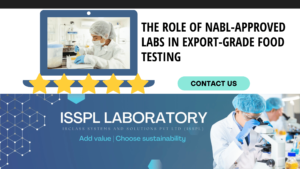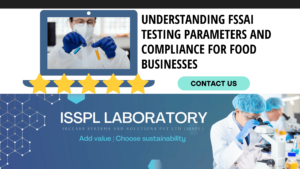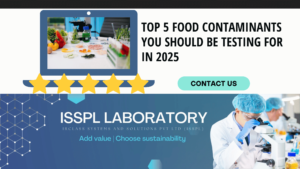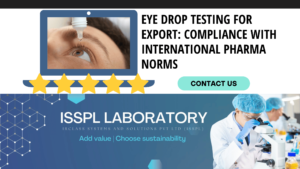An Overview by Team ISSPL - Analytical Testing Laboratory in India
ToggleBeverage lab testing is more than just checking if a drink tastes good. It’s a science-led process that ensures quality, safety, and compliance. From bottled water to soft drinks to health beverages, testing makes sure every bottle meets both customer expectations and legal standards.
But testing doesn’t start in the lab—it starts with sampling. Every step after that matters. If the sample is wrong, the whole test is wrong. This guide walks you through the full process, step by step. From the moment the bottle is opened to the time you read the Certificate of Analysis (COA), every stage plays a role in getting results you can trust.
Why Beverage Testing Is Done
Beverages go through many stages before they reach a shelf. Ingredients are mixed, processed, filtered, packaged, and shipped. At every point, there’s a chance for something to go wrong.
Testing is how companies protect their brand and customers. It ensures that the drink is safe to consume, the label is accurate, and the product is consistent from batch to batch.
It also protects companies legally. Without test results, there’s no proof a product meets the rules set by FSSAI or international bodies. That’s why beverage testing isn’t optional—it’s built into every serious production plan.
How to Take Samples Correctly
Sampling is the foundation of beverage testing. If your sample is contaminated, outdated, or poorly handled, the test won’t reflect reality.
Samples should be taken from the final packaged product—this is what the consumer will get. Use clean, sterile tools. Label every bottle clearly with batch number, time, and date.
Avoid plastic if you’re testing for compounds like phthalates or BPA. For microbial testing, chill the samples and deliver them quickly. Always follow your internal SOP or the lab’s protocol to avoid rejections.
What Physical Tests Are Done
Physical tests check the look, feel, and stability of the beverage. These tests are often fast, but they give critical insights.
– Appearance: Is the drink cloudy? Is there sediment? Any discoloration?
– Turbidity: Measures how clear the beverage is using light-based equipment.
– pH: Indicates acidity. Helps with shelf life and flavor control.
– TDS (Total Dissolved Solids): Especially for water-based drinks. Affects taste and mineral content.
Physical tests are usually the first round of checks. They don’t require advanced equipment but offer fast answers if something seems off.
Chemical Tests and Why They Matter
Chemical tests go deeper. They confirm what’s inside the drink and whether it matches the label.
– Sugar Content (°Brix): Measured with a refractometer. Important for juices and soft drinks.
– Preservatives: Like benzoates, sorbates, or sulphites. These have strict legal limits.
– Acidity/Alkalinity: Impacts flavor, stability, and preservation.
– Mineral Content: For bottled water and health drinks. Includes calcium, magnesium, sodium, and potassium.
– Additives and Colorants: Must be within FSSAI-approved limits.
Some drinks also need to be tested for caffeine, vitamins, or plant extracts, depending on the type of product. Labs often use HPLC, GC-MS, or UV spectroscopy for these tests.
Microbial Testing: Safety First
This is where health and safety meet head-on. Microbial tests look for bacteria, yeast, mold, and pathogens. Contamination here means the drink is unsafe—and unusable.
– Total Plate Count (TPC): Shows general bacterial load.
– Yeast & Mold: Common in sugary or fermented drinks.
– Coliform & E. coli: Indicates fecal contamination or poor hygiene.
– Salmonella, Listeria, Staphylococcus: Serious pathogens tested in sensitive beverages.
Samples must be handled with care. They’re usually tested within 24 hours, and cold chain is critical. Even a short exposure to room temperature can give wrong results.
Understanding the Certificate of Analysis (COA)
The COA is the final report you get from the lab. It lists all the tests performed and whether the results meet the defined limits.
Each test line will include:
– The parameter name (like pH, TDS, Caffeine)
– The method used (such as IS, AOAC, or in-house method)
– The result (usually with units)
– The specification limit
– Whether the result is Pass or Fail
Reading a COA isn’t hard, but you have to know what you’re looking at. Pay attention to anything marked “Out of Spec” or values that are on the edge of the limit. That’s your early warning system.

How Long Does Testing Take?
It depends on the drink and number of tests. Physical and basic chemical tests can be done in 1–2 days. Microbial testing often takes 3–5 days due to incubation. Heavy metal, pesticide, or vitamin analysis may take up to a week.
If you’re launching a new product or need an export clearance, plan your production around the testing timelines. Rushing the process can mean missed deadlines or bad results.
Common Testing Mistakes to Avoid
– Taking samples from the wrong stage of production
– Using unclean or incorrect containers
– Not labeling the sample with batch info
– Ignoring sample temperature during transport
– Misinterpreting COA values without expert input
Every mistake here can lead to delays or failed results. Training your team on the basics of sampling and test result interpretation helps avoid costly errors.
Routine Testing vs. R&D Testing
Routine testing is done for every batch, to make sure the product meets quality standards. R&D testing, on the other hand, is for new formulations or changes in recipe.
In routine testing, you check known values—like sugar, pH, and microbes. In R&D, you’re exploring: trying different preservatives, testing shelf life, or verifying new claims. Both types matter. One keeps the product stable. The other helps it evolve.
When Do You Need Third-Party Testing?
If you’re exporting, third-party testing is often mandatory. Retail chains also ask for lab reports before stocking a product. In some cases, insurance providers or legal teams may require third-party validation.
Using a certified lab adds trust. It shows that the product is not just self-claimed safe—it’s been tested and proven.
Why Testing Is Not Just for Big Brands
Even small beverage producers need lab testing. It’s not about scaling up. It’s about credibility and consistency. Whether you’re making 100 bottles or 10,000, customers want to know the drink is clean, safe, and what it says it is.
Regulations apply to everyone. Testing helps avoid product recalls, penalties, or legal issues later. And in a competitive market, a tested product stands out more than one that isn’t.
Conclusion
Beverage lab testing is a step-by-step process. It starts with careful sampling, goes through physical, chemical, and microbial analysis, and ends with a clear Certificate of Analysis. Each test has a purpose—whether it’s for taste, safety, or compliance.
If you’re looking for reliable, accurate beverage testing backed by technical know-how, IRCLASS Systems and Solutions Pvt Ltd offers the expertise you need. They make sure your product is tested right the first time—and every time after that.







